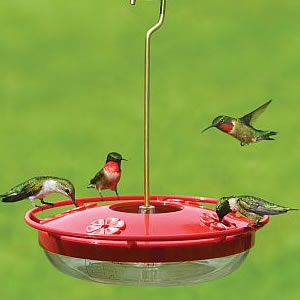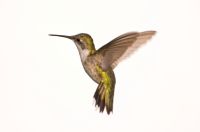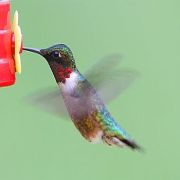Hummingbird Food Recipe
Easy hummingbird food recipe, how to make hummingbird food, hummingbird nectar recipe, hummingbird feed info and facts.
Although hummingbirds do prefer to sip natural nectar from flowers, you can have an abundance of these gorgeous birds visiting your garden.
You need to be patient while they find your hummingbird feeder. But, be assured, that once they decide to make your backyard their territory, they will be back every year!
And you will have hours of enjoyment!

It is really simple to make your own hummingbird food. It is not necessary to go to the expense of buying commercially prepared hummingbird feed and I have found that home-made nectar makes the little birds as happy as any shop bought mixture. Follow this easy recipe for hummingbird nectar and then read the tips below to help you see hummers at your feeders more often.
Hummingbird Food Recipe
The basic formula to remember is 4 parts water to 1 part sugar.
- Pour 4 cups of tap water into a large pot (try not to use aluminum).
- Add 1 cup of ordinary table sugar (DO NOT use honey, artificial sweeteners, or other sugar substitutes).
- Bring to the boil and stir until all sugar has dissolved.
- Boil for 1-2 minutes; be careful not to let water evaporate or else the nectar can become too concentrated.
- Let the nectar cool. Store in clean glass container in the fridge.
- Fill your clean hummingbird feeders as necessary.
Hummingbird Food Recipe Tips
- Sometimes I need to make hummingbird food in smaller quantities for a quick fill. I pour 1/4 cup sugar into a glass jug. Pour on 1 cup boiling water and stir until all sugar is dissolved. Add an ice-block for a quick cool down and then top up my feeder.
- Put up several smaller feeders in different locations - e.g. on opposite sides of the house; this avoids territorial disputes amongst your hummingbirds.
- Early in the season only fill feeders one-third full so as not to waste sugar water until the birds start feeding. Similarly, as the season ends, fill each feeder with less nectar.
- Put the feeders in places where you can see them. You will have hours of education and entertainment. After all, the sugar water we provide is just a little bonus for the birds, and more for our pleasure - they can get along very well without us by feeding from natural food sources.
- The question of red dye is a big one with backyard birders!
It is recommended to avoid using any type of food coloring. It can be potentially harmful to hummingbirds, as they consume a huge quantity of nectar every day. There is no conclusive scientific evidence red food coloring hurts hummingbirds, but as nearly every commercial feeder has some red on it already, it isn't necessary for you to add the chemical colouring. - You do not need to buy fancy prepared nectar mixes with vitamins and other additives; these mixes cost as much as 20 times more than regular table sugar, and many of them contain preservatives that can harm hummingbirds .
Cleaning Hummingbird Feeders
- Be sure to clean and refill your feeders at least twice a week in hot weather. Mould and bacteria breed easily in the sugary water and can cause damage to the hummingbirds. Hummingbirds are also extremely sensitive to the quality of the nectar and will look for a new source and possibly not return if they find dirty food in your feeder.
- I use hot soapy water and a bottle brush to clean my feeders. Make sure you rinse well! A mild solution of white vinegar can be used to kill the mould.
- Do not use chlorine bleach as a cleaning agent. Research shows that bleach and other alkaline cleaners can release toxins from polycarbonate plastics (e.g., Lexan) found in the material of some feeders.

Helping You Make a Wild Bird Heaven in Your Own Backyard
Go from Hummingbird Food Recipe to Best Humming Bird Feeders Go from Hummingbird Food Recipe to Best Backyard Bird Feeders Home
BIRD ID For Today
Ruby-throated Hummingbird

Adult
Ruby-throated Hummingbirds are the only breeding hummingbird in eastern North America.
- Bright emerald or golden-green on the back and crown, with gray-white underparts. Males have a brilliant iridescent red throat that can look dark when not in good light.
- Beats its wings about 53 times a second.
- They fly straight and fast, but can stop instantly, hover, and adjust their position up, down, or backwards with great control.
- Live in open woodlands, forest edges, meadows, grasslands, parks, gardens and backyards.
- They have very short legs which prevent it from walking or hopping. It shuffles along a perch.
- Nest normally on a tree branch but they are used to human habitation and have been known to nest on loops of chain or wire.
- The oldest known Ruby-throated Hummingbird was 9 years 1 month old.
- Feed on the nectar of red or orange tubular flowers, as well as at hummingbird feeders. Also catch insects in midair or pull them out of spider webs.
- Conservation status is Least Concern.





